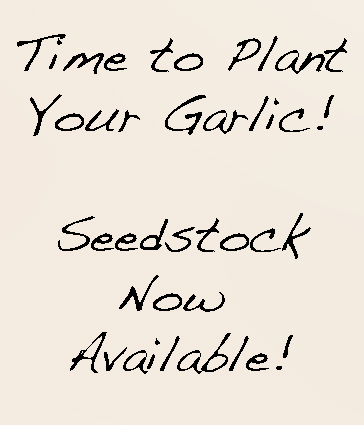I’ve written several articles about planting garlic, growing garlic, miserably failing at growing garlic, harvesting & curing garlic, and yes, eating garlic – and I have wanted to use the word, “Conundrum” in the title of every one of them. True.
 But here’s what happened: I stopped by our local farm store the other day to pick up some bone meal, and a big sign on the door proclaimed (see sign to the right) …
But here’s what happened: I stopped by our local farm store the other day to pick up some bone meal, and a big sign on the door proclaimed (see sign to the right) …
“You’re tellin’ me! I need to get my act together,” I thought, as I pushed through the door. But I was curious to see what they had. To be honest, I was taken aback. The basket of German Red on the table was – I am sorry – outright pitiful. The bulbs were pretty, pink, very clean – but barely over an inch in diameter! At $15/lb, I couldn’t believe it! Seriously? Seedstock? Ok. This is why I don’t financially make it as a farmer, but I would not even sell dinky bulbs like that, much less call them seedstock.
So even though I have written many times about growing garlic, and even though tips and techniques can be found all over the web, I felt another blogpost might be in order, simply because it’s not always as simple as it seems. But I do believe, my friends, that you can grow better seedstock than what I saw available there. To give them the benefit of the doubt, perhaps it was the end of what they had left…but still. And if that is all that is available, yes, it is totally possible to start with small cloves and build up the size over time, but at that price, you shouldn’t have to.
Why go through all the trouble to grow your own? Economic reasons, of course, but mainly because you will know exactly how it was grown, and when you take time to build really good soil, you will know you have the most nutritious, powerful, flavorful garlic ever.
Every year is different and has its unique challenges; sometimes it seems like a scratching process – I am scratching my head & starting from scratch at the same time. Sure, there are some general rules of thumb, but starting with strong seedstock (preferably your own or something local, adapted to your climate), the right location, soil conditions, and out-of-your-control weather can make a huge difference from one crop to the next. And therein lie the conundrums, dilemmas, and paradoxes that make growing this crop so interesting. So, in the spirit of Always Question Authority, I thought I might take a closer look at some of the garlic-growing mantras.
Issues that always come up include how much to plant and where and how to plant it, crop rotation, space requirements, companion planting, weeding, tilling, and other ways of disturbing the soil, and a lot of etcetera. After you answer the questions, you still might need to revisit them before you fully commit, just so you understand the far-reaching implications. As my mother used to tell me, “It’s all about choices” (and consequences).
Of course, when I wrote all this out, I found myself going on for about 6 pages. So to make it a little more digestible, I decided to divide the ideas up into chunks.
In the process, I realized that there is a lot of thinking that goes into growing garlic, more than people would think. I mean, I know there are some who find a clear spot of ground, poke their finger into it, and drop in a clove. These people are probably left-brained types who have the knack for seeing the simplest way forward. I know they exist because I am married to one.
For me, though, I have to look at the garden from all sides first. I have even set up an assortment of hiding places for doing just this, unseen, of course, which is how you can get the best unadulterated views and can consume quantities of dark chocolate, conducive to both clear thinking and visioning (which the dictionary defines NOT as daydreaming, but as “intelligent foresight,” in case you wondered). But that is for another post.
To begin, we Enter the Situation Room
The situation room is one we will revisit, and revisit often.
It starts with evaluating your personal circumstances – where you are in life, your goals and aspirations, how you can pick up after messing up…
No, no, no – not THOSE personal circumstances! That’s what you do when you are out weeding and mulching. I MEAN assessing your land.
Of course, if we are on top of things, we would have all this planned out last year and maybe even two years ago. Ideally, that’s the way it works; in real life, not always.
Don’t get me wrong, I’ve been thinking about this for months and even longer. In my sleep, in fact. And the thing that keeps me awake at night is…
Rule #1: Rotate Your Crops
You may laugh, but this is the crux of the problem for me. Crop rotation is Rule #1 in Disease Management. My innocent son asked me, “If garlic is supposed to be so antifungal, antibacterial, and such a great pest repellant, why would you need to rotate it?” Ahhh….out of the mouths of 23-year-old babes. It’s a good question. Depletion of nutrients in the soil can be amended from year to year with compost and quick cover crops, so that’s not necessarily the issue. However, even though garlic is a highly effective medicinal plant, it can still be affected by pathogens lurking in the soil, which can effectively eliminate your ability to ever grow garlic in that place again. Ever. Think about that one.
This is a case where an ounce of prevention is worth a pound of cure. Build the health of the soil and you will build the health of the plant. Encourage abundant microorganisms through crop diversification, cover crops, and removing the pathogen food source. We have a lot of fungus and molds in the Pacific Northwest, some of which are beneficial and many of which are not; when it comes to garlic, I don’t risk it. I rotate. I also spin in circles, but that’s a different skill. Which brings me to…
Garlic Growing Quandary #1: Where to Plant the Garlic
So here’s my problem: I used to have six 25-foot-square plots (more or less) around which I rotated my garlic and veggies. Key words: “used to have.” For in the spirit of permaculture and the enthusiasm of building a backyard food forest of our very own, I have filled them all up with perennials – nuts, berries, willows, shrubs, herbs, flowers for bees, wildlife plants – even a kiddie pool to catch the runoff from the rainwater catchment containers. I kid you not – I went a little crazy, and all the plants seemed rather small at the time (ahm).
I went from this:

(of course, the plotted-out paper version makes things so understandable!)
To this:

What to do?
I would have to forge new ground! Such an adventure!
Reality Check #1: Whoaaa. This Will Be a LOT of Work! (consequences, consequences…)
If this has happened to you, you know what a daunting task it can be to turn an old pasture into a fertile Garden of Eden, because quackgrass and thistles do not go away willingly, and as much as I love dandelions, they are not the best companions with garlic. It’s enough to make me ask, “Why am I growing this high-maintenance crop anyway?” Such blasphemy! I did not really think that. I consider this a strengthening exercise.
Ok. So last year, I skirted the issue by creating a bed of compost-over-cardboard-over pasture grass, a last-ditch effort that did surprisingly well, although not ideal. (After harvest, I planted a winter salad garden and some herbs, which are doing beautifully).
As much as I hate tillers, I knew I needed to think ahead for the following year, so at the time we built the aforementioned bed, we also turned over a large rectangle of land in which I planted a clover-rye-vetch-alfalfa-buckwheat-fava mix (whatever seed I had on hand). THIS, I decided, would be the ideal place for “next year’s”, i.e., THIS year’s, meaning NEXT year’s harvest. And that’s how you have to think.
Ok. So it wasn’t ideal. The tiller effectively cut the roots into bits so they could grow even more thickly, and then the tiller broke. Good riddance! We knew this would happen! Grass, dandelions, thistles – they grew everywhere. Fortunately, though, the cover crop mix was thick and strong enough to prevail.
Undaunted, I got out my scythe, my reaper of mass construction and the most life-changing tool I have ever owned (more about this in an upcoming post). Suffice to say, in a matter of minutes, I leveled everything to the ground and felt very powerful, indeed. With a meditative determination, I continued into the field and harvested even more grass and piled it on top, seeds and all. My husband got into the zen-like trance of cutting, too, and although still neophytes, before long, we had cleared the entire field and piled the surplus on the edges to keep the weeds at bay as well as around the string of shrubs I affectionately call the “wildlife corridor.” In fact, he got so into it, he also cleared out a little camping area where we slept most of our summer nights…and it was quite beautiful.
But back from my reverie to the future garlic bed plot: On the north end, we later cleared away a circle and planted a mulberry tree surrounded by a ring of oca roots. Beautiful! When the weather warmed, we dug through the mulch and planted these amazing Malabar squash, which were slow in starting, but eventually added to the cover. We heavily mulched them with more scythe cuttings. In some areas, dandelions grew through the mulch like a thick carpet (Something that out-competes grass! Nothing stops them!). Thistles that came up were much easier to control. Grass was still to be found, but mainly in clumps here and there. And despite all the mulch, the sod beneath was still not very decayed – lesson learned: it takes more than a season.
Realization #1: Sometimes you just gotta work with what ya got.
Back to The Situation Room. For this year (i.e., next year’s crop), it appears that this is still the best spot I have for planting garlic. Sure, I could put some bulbs here and a few bulbs there all over the place, but as my perennials are growing larger, I am finding it a challenge to find that “full sun” spot that the garlic craves. So it looks like this is it.
Looks like we still got a lotta work to do.
My points being – to grow really great garlic, you need to rotate your crop, and to do that, you need to always be thinking ahead a couple of years, at least, so you can make sure you have a sunny spot available and have time to build the soil; and if you end up having to break new ground, it can be a lot of work, but in the end, SO worth it. Pick your battles carefully!
More on how I pulled this together to make my best garlic beds ever in my next post.
~*~
P.S. If you are looking for a good place to get a quality scythe, look no further: Scytheworks